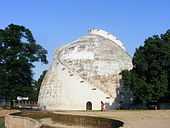Golghar
| Golghar | |
|---|---|
 Golghar | |
| Former names | The Granary at Patna |
| General information | |
| Architectural style | Stupa |
| Location | Patna, Bihar, India |
| Coordinates | Coordinates: 25°37′13″N 85°08′22″E / 25.6203374°N 85.1394483°E |
| Current tenants | Bihar Government |
| Completed | 20 July 1786 |
| Client | Bihar government |
| Owner | Bihar Government |
| Landlord | Bihar Government |
| Height | 29 m |
| Technical details | |
| Diameter | 125m |
| Design and construction | |
| Architect | Captain John Garstin |
The Golghar or Gol Ghar (गोलघर), ("Round house"), located to the west of the Gandhi Maidan in Patna, capital of Bihar state, India. It is a granary built by Captain John Garstin, in 1786.[1][2]
History
After the devastating famine of 1770, which killed nearly 10 million people in regions of Bengal, Bihar and modern day Bangladesh, Warren Hastings, then Governor-General of India, ordered the construction of this beehive shaped structure for the purpose of storing grains for the British Army.[3] It was conceived and built by Captain John Garstin, an engineer with the East India Company,[4] and has a storage capacity of 140000 tons, it construction was completed on 20 July 1786.
A drive to improve the appearance of the structure was begun in 2002.[5]
The architecture
Built in the native Stupa architecture, the building has a foundation of 125m, and a height of 29 m. It is pillarless with a wall of thickness of 3.6 m at the base. One can climb atop the Golghar through the 145 steps of its spiral stairway around the monument. The spiral staircase was designed so as to facilitate the passage of the coolies, who had to carry grain-bags up one flight, deliver their load through a hole at the top, and descend the other stairs.
The top of the Golghar presents a wonderful panoramic view of the city and the Ganges flowing nearby. At time of its construction, it was the tallest building in Patna.[citation needed]
Golghar has never been filled to its maximum capacity and there are no plans to do so. The reason for this is a flaw whereby the doors are designed to open inwards. Thus, if it is filled to its maximum capacity, then the doors will not open.[citation needed] Presently renovation of this historical monument is in underway.[citation needed]
Gallery
-

Golghar, Patna, painting of 1888
-

Gol Ghar, Patna, a 19th-century painting
-
Gol Ghar, Patna 19th century painting
References
| Wikimedia Commons has media related to Golghar. |
- ↑ Golghar, 1888 Victoria & Albert Museum.
- ↑ "Destinations :: Patna".
- ↑ Golghar
- ↑ Golghar Directorate of Archaeology, Govt. of Bihar, official website.
- ↑ Development of Golghar as tourist site in limbo The Times of India, February 15, 2002.
.JPG)